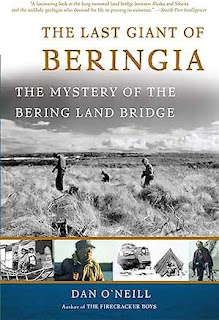This image shows the Bering Land Bridge as it would have looked during the ice ages. The land bridge was a vast, grassy plain that connected Asia and North America. It was possible for people to walk from one continent to the other, which is how the first people arrived in North America.
The Bering Land Bridge was a landmass that connected Asia and North America during the ice ages. It was a vast, grassy plain that allowed people to walk from one continent to the other.
Scientists believe that the first people to arrive in North America crossed the Bering Land Bridge between 15,000 and 20,000 years ago. These people were likely from East Asia, and they brought with them their own unique cultures and traditions.
Book: The Last Giant of Beringia: The Mystery of the Bering Land Bridge: https://amzn.to/3r9SNUj
One of the most interesting things about the first people to arrive in North America is that they were likely darker-skinned than the people who live in North America today. This is because the people who lived in East Asia at the time were darker-skinned, and the Bering Land Bridge was not covered in ice, so the climate was relatively warm.
As the ice ages ended and the Bering Land Bridge submerged, the people who lived in North America began to intermarry with people from other parts of the world. This led to the diversification of the population, and the darker-skinned people who had originally migrated from Asia became a minority.
However, there are still many people in North America who have darker skin, and their ancestors can be traced back to the people who crossed the Bering Land Bridge. These people are a vital part of the cultural and historical fabric of North America, and their stories deserve to be told.
Additional Further Research
The Bering Land Bridge: How Migration Across the Continent Shaped North America's Genetic Diversity
The migration of darker-skinned people to North America through the Bering Land Bridge is a captivating chapter in human history that has significantly influenced the continent's genetic diversity. This article explores the remarkable journey of these early migrants and the lasting impact they have had on the populations of North America.
The Bering Land Bridge, also known as Beringia, was a landmass that connected present-day Siberia (Asia) and Alaska (North America) during the last Ice Age. Spanning approximately 1,000 miles, this land bridge emerged as a result of lower sea levels caused by massive ice sheets locking up water.
As the title suggests, darker-skinned people ventured across the Bering Land Bridge into North America. These individuals were descendants of early humans who had migrated out of Africa thousands of years prior. Over time, they adapted to the harsh Arctic environments, developing unique physical traits that helped them survive in the region.
The migration across the Bering Land Bridge occurred in multiple waves, with different groups of people making the journey over thousands of years. These migrations brought a diverse range of cultures, languages, and genetic lineages to North America, shaping the continent's population as we know it today.
Genetic studies have provided valuable insights into the impact of the Bering Land Bridge migration on North America's genetic diversity. Researchers have identified distinct genetic markers and ancestral lineages that can be traced back to the early migrants. These markers are particularly prevalent among Indigenous populations across the continent, highlighting the profound influence of the Beringia migration on their genetic heritage.
The story of the Bering Land Bridge migration not only sheds light on the origins of North America's Indigenous populations but also challenges traditional narratives surrounding the settlement of the continent. It highlights the rich complexity of human migration and the interconnectedness of diverse cultures and communities.
Understanding the history of the Bering Land Bridge migration is crucial for appreciating the cultural diversity and heritage of North America. It serves as a reminder that the continent's population is a vibrant tapestry woven together by the journeys and experiences of countless generations.
As scientific research continues to advance, our understanding of the Bering Land Bridge migration will undoubtedly deepen. By exploring the genetic legacy of these early migrants, we can gain a greater appreciation for the contributions they have made to the cultural mosaic of North America and celebrate the diverse tapestry of humanity that spans across the continent.


No comments:
Post a Comment
Welcome to Leave a Comment